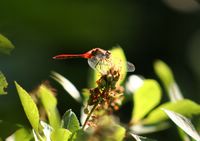The HP Scanner "Copy" Dialog, a new low.
Monday, August 29, 2005
Ghostweather: The HP Scanner Dialog
Saturday, August 27, 2005
History of Social Networks Analysis
Freeman defines social network analysis as having four key features: a structural intuition, systematic collection of relational data, graphic images, and mathematical or computational models. (I would add a fifth feature that is ancillary yet crucial: a study of the flows through the network.) The first four features alone tend to produce a static network, though in Freeman's own work flows are often important. When flows are added, networks become channels through which ideas, values, friendship, esteem, money, sales, disease, or almost anything can travel. The same network structure may pass flows of different kinds, or different structures may better facilitate different flows. The impact of social network analysis and its utility depends in large measure on which flows are studied. The way the different flows capture the popular and academic imagination determine, in part, the place of network analysis.
There were plenty of kooky characters in this history, like in any academic field: Moreno had dark side: "self-centered, self-serving ... admitted hearing voices, he sometimes thought he was God, and he was convinced that others were always stealing his ideas" (p. 31). Though to gain a full appreciation of his bizarre side, there is nothing like reading Who Shall Survive, available in the original 1934 edition for about $175 (what to give your favorite network scholar) or the even more bizarre 1953 edition that -- oddly -- costs about the same. "For the most part Moreno seemed to be unfocused but, when he was involved with a woman who could serve as a muse, he succeeded in concentrating and was able to write" (p. 34).
Ew. On the other hand, it's probably a fun read.
Thursday, August 25, 2005
TiVo's investor call
Haunted Korean Airplane
Sunday, August 21, 2005
Wednesday, August 17, 2005
danah boyd: the biases of links
The dark-- or at least gray-- side of blogging includes the fact that most of the Technorati Top 100 blogs are group blogs or professional blogs, usually aimed at marketing in some way. I suppose it makes good business sense to hop on the buzz-mot-du-jour bandwagon, just like Hagel and Armstrong did with Net Gain: Expanding Markets through Virtual Community. Who people link to in their sidebar, their "blogrolls" (which are often labeled "who we read"), is overwhelmingly gendered, in her sample. And the top dogs all get linked to, but don't link anyone.
It's not a solid quantitative research study, but it's interesting to read.
Monday, August 15, 2005
Levitated | Jared Tarbell
Seriously, go now, and play. Try the walking insect generation or the walking things that change when you click on them or the gorgeous 3-d text space (I just wish it were infinite).
Sunday, August 14, 2005
Color Words and Color Products
Martin Wattenberg has a fascinating look at the colors that lie behind the lexicon in his Color Code: A Color Portrait of the English Language. It's really fun to browse and mouse around, like most of Martin's work.
And this guy over on Flickr has Safeway aisles as color bars, abstractions of the colors of products in an American supermarket. They're surprisingly pretty.
Saturday, August 13, 2005
Complexification
Update to add: There's some entertaining explanation of the simulations behind the art, especially the robot offspring one: Offspring is a visualization of the pair bonding process of a theoretical robot colony. Each robot is assembled, ages through youth, comes into a reproductive stage, and eventually dies of fatigue. If a robot is lucky enough to find a mate during it's reproductive stage, baby robots may be assembled.

Folding T-shirts
His most popular blog entry is about how to fold t-shirts. Here's more on the phenomenon: Pavel's Blog: A Very Specialized Website.
Wednesday, August 10, 2005
Whose Fish?
There are five houses in a row in different colors. In each house lives a person with a different nationality. The five owners drink a different drink, smoke a different brand of cigar and keep a different pet, one of which is a Walleye Pike. The question is-- who owns the fish?According to the home page on Coudal Partners, over 7000 people wrote in, and over half of them got it right.
Hints:
1. The Brit lives in the red house.
2. The Swede keeps dogs as pets.
3. The Dane drinks tea.
4. The green house is on the left of the white house.
5. The green house owner drinks coffee.
6. The person who smokes Pall Malls keeps birds.
7. The owner of the yellow house smokes Dunhills.
8. The man living in the house right in the center drinks milk.
9. The man who smokes Blends lives next to the one who keeps cats.
10. The Norwegian lives in the first house.
11. The man who keeps horses lives next to the one who smokes Dunhills.
12. The owner who smokes Bluemasters drinks beer.
13. The German smokes Princes.
14. The Norwegian lives next to the blue house.
15. The man who smokes Blends has a neighbor who drinks water.
Sunday, August 07, 2005
Saturday, August 06, 2005
Quantum information can be negative
One can also have situations where someone knows more than everything. This is known as quantum ‘entanglement’, and when two people share entanglement, there can be negative information.
I'm pretty sure I've seen this situation, even without quantum particles.
Rob's Amazing Poem Generator
I fed it a few URLs including my own, but the results I like best come from my favorite website for oddities, The Anomalist. I think they're probably better than average because the theme is more uniform.
THE standard gravitational model.
East Kingston Woman Reports a big
Foot. Is overloaded with Big
Bang theory of exploding stars in front of the hydrophone. The
Books and about
three four feet long and
Orkney was
actually
fairly common during hurricanes. And: vibrated.
Friday, August 05, 2005
Groups and Teams and Growing Pains
If you've got deja vu because you remember my post, well, so do I, since I'm going through the same phenomena yet again with a new group-- supporting how universal his observations were. Tuckman's stages are these, named with silly names (I'm quoting from here) :
- Forming: The group gets to know each other. It's non-threatening. The major task functions also concern orientation. Members attempt to become oriented to the tasks as well as to one another. Discussion centers around defining the scope of the task, how to approach it, and similar concerns.
- Storming (my favorite because it's the one I always notice and hate): Because of "fear of exposure" or "fear of failure," there will be an increased desire for structural clarification and commitment. Although conflicts may or may not surface as group issues, they do exist. Questions will arise about who is going to be responsible for what, what the rules are, what the reward system is, and what criteria for evaluation are. These reflect conflicts over leadership, structure, power, and authority. There may be wide swings in members’ behavior based on emerging issues of competition and hostilities.
- Norming: Group members are engaged in active acknowledgment of all members’ contributions, community building and maintenance, and solving of group issues. Members are willing to change theirpreconceived ideas or opinions on the basis of facts presented by other members, and they actively ask questions of one another. Leadership is shared, and cliques dissolve. When members begin to know-and identify with-one another, the level of trust in their personal relations contributes to the development of group cohesion. It is during this stage of development (assuming the group gets this far) that people begin to experience a sense of group belonging and a feeling of relief as a result of resolving interpersonal conflicts.
- Performing: The Performing stage is not reached by all groups. If group members are able to evolve to stage four, their capacity, range, and depth of personal relations expand to true interdependence. In this stage, people can work independently, in subgroups, or as a total unit with equal facility....Members are both highly task oriented and highly people oriented. There is unity: group identity is complete, group morale is high, and group loyalty is intense. The task function becomes genuine problem solving, leading toward optimal solutions and optimum group development. There is support for experimentation in solving problems and an emphasis on achievement. The overall goal is productivity through problem solving and work.
The Big Dog site points out that groups aren't teams, and the above stages really characterize the formation of teams that work towards a known, shared goal.
While teams have an identity, groups do not. It is almost impossible to establish the sense of cohesion that characterizes a team without this fundamental step. A team has a clear understanding about what constitutes the team's 'work' and why it is important. They can describe a picture of what the team needs to achieve, and the norms and values that will guide them. Teams have an esprit that shows a sense of bonding and camaraderie. Esprit is the spirit, soul, and state of mind of the team. It is the overall consciousness of the team that a person identifies with and feels a part of. Individuals begin using "we" more than "me."
The formation of teams requires some special commitments -- everyone knows everyone is on board and working for the same goal; they can be relied on. If some of the members aren't reliable, or have split loyalties and agendas, there's not going to be a real team at the end of the day. There are lots of potential barriers, including prior history; I think I'm currently part of a subclique in the new group composed of survivors of another successful team (where some group members evolved to a real team and others dropped out); we're dubious about whether the new group will become a team, given what has gone before and who we're missing now.
Teamwork is hard to get right, that's all there is to it.
Next-Gen Tools in Global Software Development
Some of Barney's big takeaways from the panel discussion:
- Individual programmer productivity is always nonuniform. Some programmers are 10 or even 100 times as productive as others.
- The results of outsourcing are often disappointing
- A recurring theme in the panel was the difficulty and importance of getting software requirements right. Despite all the improvements in tools and processees for developers, there have been limited improvements in the way people create and validate the requirements in the first place. Errors in requirements ripple through the downstream flow and get more expensive to fix the later they are caught.
I contend that a good user-centered design process that starts during requirements gathering will achieve the results that are wanted, assuming the business has a goal that's addressing a real user need. A good designer helps bridge that communication gap between business analysts and "the IT folks who got it wrong." More of Barney's notes:
"Do your business people and IT people understand each other? Answer to this is usually 'no.' The problem: Missing, ambiguous and contradictory requirements. 60-80% of project failures can be attributed to requirements errors. at the very front of the process. not the arch, dev, or testers! The biz people say you didn't understand, the IT guys say you didn't explain. Scope creep and rework usually mean you didn't find the errors it the beginning; Good requirements are hard. Requirements definition and validation cycle: informal primarily text requirements -> spec -> formal spec documents -> validation -> visual inspection and review of spec for errors -> elicitation. This is a laborious process, with error detection that's bad."
Almost every usability practitioner in industry or consulting moans about "not being involved early enough." That moan is usually because the problem is with the requirements, on a project that's already made it to the point where it's too late to change direction....
Wednesday, August 03, 2005
The March of Pies: Gallery of Data Visualization
Blind Lemon Jefferson, the great blues musician, was once asked why there were so few white bluesmen. He replied, 'Knowin' all the words in the dictionary ain't goonna help if you got nuttin' to say.'

This image, from the graphic design book Diagraphics II, attempts to show the relative market shares of Sotheby's vs. Christies over time. The graphic designer has cleverly used a variety of tricks to show.... What? Well, it does make clear that time is increasing over time. But there surely isn't much else going on.
Faster Browsing: Browster and SNAP UltraSearch
Barney Pell's Weblog: Faster Browsing: Browster and SNAP UltraSearch
Francis Crick and the Claustrum
The post is here: Mind Hacks: Francis Crick has left the building.




